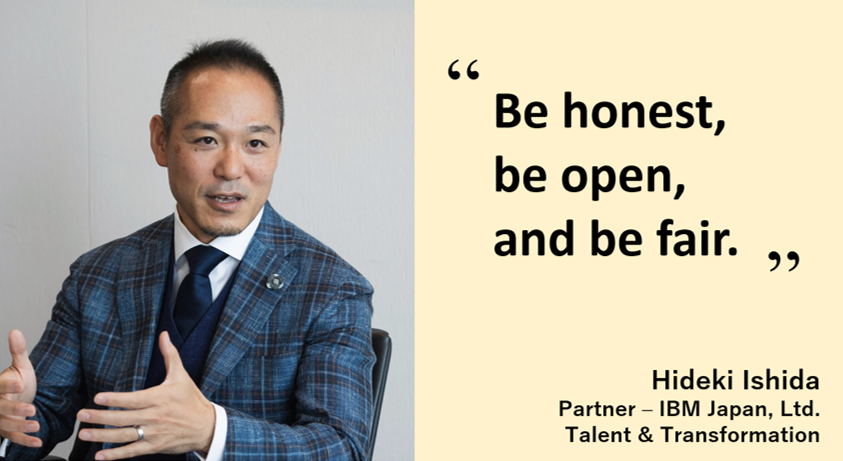Building resilient corporations requires proper communication to lead everyone to a common goal. One essential item in developing effective communication is to create an environment conducive to feedback giving and receiving.
The Nagaoka Review team had an opportunity to speak to Mr. Hideki Ishida, Partner – Talent & Transformation, Global Business Services of IBM Japan about the significance of feedback and to share some “how to” tips in managing feedback conversations.

Mr. Hideki Ishida of IBM Japan, Ltd.
HI: Hideki Ishida; NR: The Nagaoka Review
Types of Feedback
NR: Thank you very much for taking time off to speak with the Nagaoka Review team. We are glad to have you share your expertise in talent management. We have some questions for you regarding feedback, and we hope you would be able to share your thoughts with us!
HI: Certainly!
NR: There are two different types of feedback, namely Task Feedback and Relationship Feedback. Could you tell us more about it, and how are both different?
HI: The best way to differentiate these two would be something like this:
Task Feedback is all about tasks, not about people. Let’s consider points such as work-related feedback, assignments, or task-related activities such as time management, output level and skills.
On the other hand, Relationship Feedback is people related. It is difficult to give suggestions and comments about one’s personality or style. As such, it is critical to be fair based on facts. The best method is through evidence-based communication.
NR: What is the main reason why people do not know the difference between these two types of feedback?
HI: To put it simply, most people do not know or understand the notion of feedback, let alone how to give or receive feedback effectively!
Feedback in a Japanese Business Setting
NR: In a typical Japanese business setting, what is a good interaction ratio between a manager and the employee?
HI: Ideally, a 50-50 interaction ratio throughout the feedback session is ideal, as it is an even split. Unfortunately, we all know too well that this is utopian and does not reflect much of reality.
In the context of the Japanese business environment, it is common for companies to make such feedback session a rule or just a mere business expectation. At the same time, it is not the ideal situation. The culture in Japan is slightly different, and rules are considered to be a part of a strong governance system. Having a genuine career conversation is a challenge. Hopefully, we could work towards creating a fair discussion and relationship between the two parties.
To mitigate the situation, I would recommend both managers and employees to make more conscious use of empathy. Be more human and aim to understand. An understanding manager would say something along the lines of, “I am committed to helping you grow your career and search for new and exciting opportunities”. It is also crucial for both parties to practice active listening and keeping an open mind. Besides that, it is important to listen intently to comments, suggestions, or ideas that surface during the session.
Maximizing Feedback Through Challenge Mitigation
NR: There is always a possibility of denial or unpleasant situation during feedback session. What would you recommend as a course of action?
HI: One point to note would be this:
Change readiness

Assessing one’s change readiness is key to effective feedback. Image by Braden Collum via Unsplash
Managers should assess the change readiness of a person, whether someone is ready to listen or not. Tone-setting is crucial in starting the conversation. The feedback giver should help the feedback receiver understand that they are on the same page, going towards the same goal and that they are in alignment. At the same time, it is particularly important to assess the situation during the conversation to determine what is the best way to communicate your point across.
We would assess a few points by asking questions related to stagnation or fear. Having a two-way communication is key to getting people to share how they feel. Moreover, I would highly recommend people to take the conversation in a “step-by-step” manner.
”When someone responds, listen with the intention of having an accurate understanding. Then, confirm what you understand. If something does not make sense or comes across in an unintended manner, consider rephrasing.
Hideki IshidaPartner, Talent and Transformation, IBM Japan Ltd.
Tips on Managing Feedback
NR: How often should feedback be given?
HI: It is essential to create opportunity for people to give and receive feedback from each other frequently. Waiting to conduct an annual or bi-annual feedback might not be the best solution but this is what corporations are practicing these days, unfortunately. When one notices something going on or something that requires attention, the best course of action is to immediately share meaningful insights. One needs to create the opportunity for the feedback receiver to rethink the situation. Should there be such a thing as an ideal timeline, I’d say once a week.
NR: Providing negative feedback is inevitable, even though most people would like to avoid receiving it as much as giving it. Could you share some pointers on how we could mitigate unpleasant situations?
HI: One tip to give negative feedback related to relationship is to use as general and inclusive as possible vocabulary such as “we” or “our team”, so we do not single a person out or mention another person’s name. Moreover, it is not a wise idea to use one’s own opinion like “I think” or “I feel”.
Rather, phrases such as “in this company”, “our team”, “it is recommended that”, “it is best practice to …”, and “it is not considered appropriate to…” are considered better choices.
Adding further Emotional Intelligence (EQ) and Cultural Intelligence (CQ) considerations to the conversation would also help the receiver associate with the key messages of the feedback provided.
Another useful phrase one could use would be, “I received information from our client on some challenges faced with our behavior that does not match their expectations”. The next thing you could say would be, “How do you feel about this statement? Any thoughts or insights?”. This is crucial, because feedback giver should also listen to the thoughts of the feedback receiver to better understand the situation.
In many situations, the feedback receiver becomes defensive and “shut down” reception. It is therefore necessary that the feedback provider prepares for this situation and help the receiver “open up” and be more receptive to the key points of feedback, as well as to commit to relevant changes.
The feedback provider needs to bear in mind that, ultimately, feedback needs to be engineered towards behavioral change, not merely a transfer of information.
Always remember to provide opportunity for people to think what the real problem is, allow them time to reflect on their behavior or actions, as well as to find opportunities for improvement. The goal is to have a fair interaction output.
NR: How would you summarize the essential points of a successful feedback session?
HI: Be honest, be open and be fair!
NR: Thank you very much for your time. We really hope to talk with you again on another topic soon!











